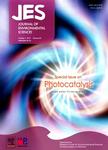Formation and control of disinfection byproducts and toxicity during reclaimed water chlorination: A review
Formation and control of disinfection byproducts and toxicity during reclaimed water chlorination: A review作者机构:Environmental Simulation and Pollution Control State Key Joint Laboratory State Environmental Protection Key Laboratory of Microorganism Application and Risk Control (SMARC) School of Environment Tsinghua University Beijing 100084 China Key Laboratory of Microorganism Application and Risk Control of Shenzhen Graduate School at Shenzhen Tsinghua University Shenzhen 518055 China Shenzhen Environmental Science and New Energy Technology Engineering Laboratory Tsinghua-Berkeley Shenzhen Institute Shenzhen518055 China
出 版 物:《Journal of Environmental Sciences》 (环境科学学报(英文版))
年 卷 期:2017年第29卷第8期
页 面:51-63页
核心收录:
学科分类:083002[工学-环境工程] 0830[工学-环境科学与工程(可授工学、理学、农学学位)] 08[工学]
基 金:funded by the National Natural Science Foundation of China (Nos.51578308, 51678332) the International S&T Cooperation Program of China (ISTCP) (No.S2016G6030) the National Water Pollution Control and Treatment Science and Technology Major Project (No.20122X07302002) the Shenzhen Science, Technology and Innovation Commission (No.JCYJ20160125095838752) the Collaborative Innovation Center for Regional Environmental Quality
主 题:Reclaimed water Chlorination Disinfection byproducts Toxicity Precursor
摘 要:Chlorination is essential to the safety of reclaimed water; however, this process leads to concern regarding the formation of disinfection byproducts(DBPs) and toxicity. This study reviewed the formation and control strategies for DBPs and toxicity in reclaimed water during *** regulated and emerging DBPs have been frequently detected in reclaimed water during chlorination at a higher level than those in drinking water, indicating they pose a greater risk to humans. Luminescent bacteria and Daphnia magna acute toxicity, anti-estrogenic activity and cytotoxicity generally increased after chlorination because of the formation of DBPs. Genotoxicity by umu-test and estrogenic activity were decreased after chlorination because of destruction of toxic chemicals. During chlorination, water quality significantly impacted changes in *** tended to attenuate toxicity changes by reacting with chlorine to form chloramine,while bromide tended to aggravate toxicity changes by forming hypobromous acid. During pretreatment by ozonation and coagulation, disinfection byproduct formation potential(DBPFP)and toxicity formation potential(TFP) occasionally increase, which is accompanied by DOC removal; thus, the decrease of DOC was limited to indicate the decrease of DBPFP and TFP. It is more important to eliminate the key fraction of precursors such as hydrophobic acid and hydrophilic neutrals. During chlorination, toxicities can increase with the increasing chlorine dose and contact time. To control the excessive toxicity formation, a relatively low chlorine dose and short contact time were required. Quenching chlorine residual with reductive reagents also effectively abated the formation of toxic compounds.



